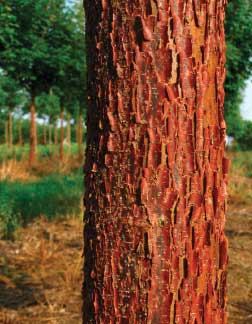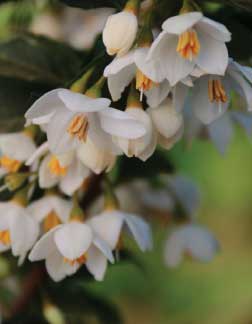Growers and researchers seek short, tidy and tough trees that can coexist with utilities
When the power goes out in a storm, daily life halts abruptly. Our TVs go dark; we can’t cook our food or keep it cold, much less brew coffee, charge our many electronic devices or turn up the heat.
We are lost without our electricity, dependent on it for comfort, conveniences and communication.
Likewise, we love our trees. Their beauty softens our streets, and their leaves clean the air, cool our yards with shade and benefit birds. We need trees, too.
But trees and power lines don’t mix well. In places where trees and transmission lines interface, power providers address the problem of outages and the billions of dollars they cost annually with proactive approaches.
For starters, distribution arborists search aggressively for trees near power lines that could cause outages during weather events. They employ pruning and trimming practices to restrict the width, height and potential impact of nearby trees. And they try to educate the public about which trees and shrubs are most compatible with growing near power lines.
Nursery growers and researchers, too, help tackle the problem of tree-caused power outages by identifying, testing and producing utility-appropriate trees.
Such trees need to conform to the spaces between street and sidewalk, but size isn’t the only factor that determines which trees will do the job well: utility trees have to be tidy and tough enough to make the grade.
They can’t be messy or vulnerable to pests; they need a naturally upright habit to allow pedestrians and vehicles clear passage; and they have to withstand the challenges of average urban growing conditions in diverse regions of the country.
These are tall orders for trees!
But private and public players in the nursery industry, universities and power companies are working together to meet the need.
UtiliTrees™
J. Frank Schmidt & Son Co., a wholesale tree grower in Boring, Ore., has contributed to the effort for years by identifying and designating a list that now includes 53 trees that are “tailored to reduce the conflict between trees and utility lines,” according to the company’s UtiliTrees™ guide available at www.utilitrees.com.
Trees that make the list must stay small, rarely exceeding 25 feet based on 30-year height averages, but they must also be tough enough to survive harsh conditions. Challenges for tree health are considerable when trees are relegated to “planting pits,” those squares of ground cut into the concrete of cities, JFS Communications Director Nancy Buley said.
Among the biggest challenges are inadequate soil volume, soil compaction, limited moisture, air pollution, temperature extremes and inhospitable soil pH.
As a group, the collection of pedestrian-friendly UtiliTrees™ compiled by J. Frank Schmidt & Son Co. boast compact or vase-shaped branching that allows for pruning that doesn’t destroy the shape of the tree. These cultivars resist disease and pests, tolerate varied soils, climates and urban growing conditions, and need minimal maintenance when established in the landscape.
Trees that earn the designation UtiliTrees™ undergo 10 or more years of trial and observation before being added to the list, Buley said. Many are cultivars selected from highly variable species that are smaller in stature and offer more symmetrical form while maintaining the character of the larger forms.
Some genera — notably maple, crabapple, cherry/plum and hawthorn — account for multiple selections on the list. But since too many of one type of tree can cause different problems, diversifying the urban forest is also a valid goal. As a result, the collection has expanded to include a more diverse assortment of trees.
Examples of such cultivars include the following.
• Styrax cultivars introduced by J. Frank Schmidt, Snow Charm® and Snowcone® (Styrax japonicus ‘JFS-E’ and ‘JFS-D,’ respectively) are both reliable, easy-to-grow UtiliTrees™. Snow Charm® has larger leaves and a rounded form; Snowcone® has more finely textured foliage and a more slender, uniform shape.
• Summer Sprite® Linden (Tilia cordata ‘Halka’) was discovered at Halka Nurseries of New Jersey and co-introduced by JFS in 2000. It has proven to stay reliably small and performs well in confined city spaces.
• City Sprite® Zelkova (Z. serrata ‘JFS-KW1) was clearly unique from the beginning, Buley said: compact, dense and semi-dwarf with a mannerly, upright growth habit.
• Amur Maackia (Maackia amurensis) is an unusual, underused species that maintains an upright branching habit over the long term, performs well in poor soils, fixes nitrogen and produces clusters of white flowers in mid-summer.
• Acer griseum, the paperbark maple, has proven itself to be tough enough to withstand urban challenges. A heat-resistant hybrid and a newly-introduced cultivar, Cinnamon Girl™ and Fireburst™, offer opportunities for different growing conditions around the country. Cinnamon Girl™ (A. griseum × A. maximowiczianum ‘Molly Fordham’) boasts a narrow form and good heat resistance that make it a good choice for conditions in Georgia and other southern states and in hot summer climates where the straight species can suffer from heat, drought and humidity, Buley said. Fireburst™ claims superior branch structure, an upright, predictably uniform shape, dependably bright fall color, and exfoliating papery curls on the bark.
• Parrotia persica cultivars, including Persian Spire™ (P. p. ‘JLColumnar’) and ‘Vanessa,’ are also good choices for use near utility lines. Heat and drought resistant, they are adaptable and produce impressive fall color.
Discovered by John Lewis of JLPN Nursery in Salem, Ore. and introduced in 2013, Persian Spire™ has a unique upright form, fine texture and excellent fall color.
‘Vanessa’ was named Urban Tree of the Year by the Society of Municipal Arborists in 2014. Nominated by city foresters in British Columbia, where it is a popular street tree, it is gaining acceptance across the United States. With an upright, tight vase shape and greater density, it also boasts versatility, adaptability and low maintenance needs.
Look up, Virginia!
The late Dr. Bonnie Appleton, a longtime Virginia Tech woody crop and landscape tree production specialist, pioneered the concept of utility trees, Buley said.
With power disruptions, safety hazards, increased utility costs and disfigured trees widespread problems, Appleton sought to raise public awareness and promote the use of smaller trees beneath power lines.
With local partners, she established the first Utility Line Arboretum at the Hampton Roads Agricultural Research and Extension Center in Virginia Beach in 1995.
The local utility company erected poles and lines, and J. Frank Schmidt donated numerous trademarked Utilitrees™ to the effort.
Since then, four additional utility line arboreta have been established across the state in Abingdon, Blacksburg, Charlottesville, and Lynchburg. All use the slogan “Look Up, Virginia!” and represent a consortium of arborists, horticulturists, urban foresters, urban forest scientists and utility service providers: www.utilityfriendlytrees.org.
Dr. Eric Wiseman, associate professor of urban forestry, established the utility line arboretum at the Hahn Horticulture Garden on the Virginia Tech campus in Blacksburg and continues to evaluate which trees perform best.
In essence, the arboretum “not only raises awareness of the tree-utility conflict issue, but also gives people the opportunity to ‘test drive’ the trees before they plant them on their property or in their community,” Wiseman wrote.
All five arboreta are stocked with small stature trees that are “street tough and readily available in the industry,” Wiseman said. All have on-site signage tags that identify the trees and allow access to detailed online information for each using QR codes.
Information about the five collections on the Plantsmap website includes the specific origins of individual plants, general details about the species, cultural characteristics and ornamental values: www.plantsmap.com/organizations/452/collections.
Starting in the spring of 2006, Wiseman began scientifically rigorous evaluations of 25 varieties of UtiliTrees™ from J. Frank Schmidt. Five plants of five varieties were planted each year for five years and evaluated for five years to assess how quickly the trees grew, their growth dimensions and issues with pests or cultivation.
In particular, Wiseman tracked root suckering or sprouting, which creates problems when rootstock overtakes scions, and fruit set.
The trials started with branched bareroot liners planted directly in fields, and results are still being analyzed.
Wiseman said that preliminary results have raised concerns about fungal diseases in trees of the Rosaceae family, including crabapples and hawthorns.
A high incidence of suckering from rootstock might be resolved by normal practices in container/field grown production and needs more investigation, he said.
Wiseman is excited about several trees that have demonstrated the expected height/spread ratio and have performed exceptionally well. These include:
• City Sprite® Zelkova (Z. serrata ‘JFS-KW1), which rapidly overcomes transplant shock and has persistently high quality foliage that “looks as good in October as when it emerges from bud in April.”
• Snow Charm® Styrax (S. japonicus ‘JFS-E’), which Wiseman said is “particularly dainty for really small spaces with durable foliage and an amazing floral display.”
• Prunus ‘Spire’ which has beautiful flowers and an upright habit that fits in tight horizontal spaces.
• Cornus ‘Venus’, which produces gigantic flowers and doesn’t have disease problems.
• Malus ‘Red Barron’, a crabapple with interesting purple-green foliage that isn’t bothered by fungal diseases.
• Syringa ‘Ivory Silk’, a Japanese tree lilac that produces a beautiful floral display much later in the season.
Wiseman and his colleague at the Hampton Roads Horticulture Facility, Laurie Fox, are preparing a journal publication about the evaluations and an updated extension publication that are both due in early 2018.
Virginia Tech has been evaluating the growth and performance of small stature, utility line compatible cultivars over the last 10 years. Here research associate John Peterson measures the height growth of a City Sprite® Zelkova (Zelkova serrata ‘JFS-KW1’). Photo by
Eric Wiseman/Virginia Tech
Plan before you plant
In the New England states of Massachusetts, Connecticut and New Hampshire, a utility company called Eversource provides electricity to some 3.1 million customers.
In that heavily treed part of the country, trees are the leading cause of power outages, according to Bob Allen, manager of vegetation management at Eversource.
Besides aggressive efforts to “remove outages waiting to happen” by searching for and pruning trees that threaten power lines, Eversource has undertaken efforts to educate its customers about “the right tree for the right place for electric service reliability.”
To that end, Eversource teamed with the University of Massachusetts Stockbridge School of Agriculture on the Amherst campus to create a Utility Arboretum in which trees grow in relation to power lines.
Among arborists and green professionals with a close connection to UMass at Amherst, renowned horticulturist, woody plant expert and author Dr. Michael Dirr earned his Ph.D. in plant physiology there.
A proponent of the right plant/right place concept, Dr. Dirr helped establish the partnership between the utility and UMass staff and continues to contribute to the project, Allen said.
The Utility Arboretum opened in 2017 using recycled poles and electrical equipment. Sections of de-energized primary wires totally 1,000 feet of line were strung between seven poles, and 35 two to three-inch caliper trees were planted.
Allen reports good results from Acer triflorum, Acer pseudosieboldianum, Cornus kousa and Parrotia persica.
More trees on that site and two more arboreta are underway, with the goal of identifying “20 under 20”: 20 decorative, flowering tree species that are unlikely to need much pruning and are well suited to conditions in the area.
The second Utility Arboretum of 41 trees was planted in New Hampshire at a training field for linesmen last fall, and a third is slated to go in on the main campus of the University of Connecticut next spring.
In an effort to encourage diversity among tree choices, Dr. Dirr has suggested trying some mid-Atlantic species of trees, so crape myrtles are among those being tried at the Amherst site too.






